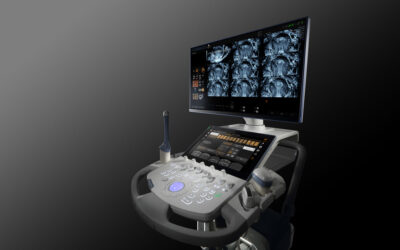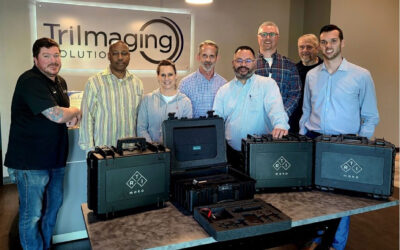By Carolyn T. Coffin, MPH, RDMS, RVT, RDCS, and Matthew Schwartz, MFA, RDMS
Every profession has a set of tools required for the work it performs and in health care, providers rely on durable medical equipment to perform their work tasks. There is an expectation that equipment purchased as used, or currently-owned equipment that has been repaired, will function as well as new equipment purchased directly from the manufacturer. In sonography, an ultrasound system consists of several components that may need periodic maintenance, repair or replacement. Heavily used ultrasound transducers often require repairs for damaged housings, internal wiring or acoustic elements. As sonographers, our ability to provide diagnostic-quality images for our patients depends not only on technical skill but also on the exacting design and manufacture of transducers used to create diagnostic images. We assume there are governmental and institutional regulatory standards that ensure the quality of the equipment we bring into direct contact with patients. But what do you know about these quality standards, or what happens to your transducer when it is sent out for repairs? If you are supplied with a repaired or remanufactured transducer, how do you know if it has been rebuilt using the original manufacturer’s components and to the original manufacturer’s specifications?
You may be surprised to learn about FDA regulatory policies for the repair or replacement of medical devices that specifically apply to ultrasound transducers. Every new transducer design to be brought to market must be filed with a 510(k) submission to the FDA to validate compliance with a wide range of standard safety measures. However, there is no provision for this filing when an ultrasound transducer has been repaired or serviced. This exposes health care facilities to counterfeit medical devices, one that contains non-validated crystals and/or cable assemblies, both critical parts to provide high-quality diagnostic images, replaced with low quality counterfeits from those of the original equipment manufacturer (OEM).1 These counterfeit parts are installed by third-party service entities and sold to the health care facility as OEM quality, which our simple study reveals is deceptive and inaccurate.
The generation of a quality image encompasses far more than just acoustic power, and the impact of diagnostic quality on patient care decision-making can have far-reaching consequences. As an initial exploration of the concept, a comparison was performed using 2 OEM transducers (L9-3 and C5-1) and 2 remanufactured transducers of the same design origin that contained non-OEM components to determine any difference in image quality. A tissue-equivalent phantom was scanned using each of the transducers to evaluate spatial resolution and acoustic penetration. The structures imaged in the phantom were a cluster of small, echogenic pins. A volunteer’s carotid artery was scanned to evaluate color saturation and vessel filling and to demonstrate the clarity of the intima-media thickness (IMT). All automatic image processing was turned off and a vascular pre-set was used for consistency. All transducers demonstrated the penetration expected for the transducer’s frequency. The pins in the phantom were imaged with higher resolution with the OEM transducers; the same structures scanned with the transducers that contained non-OEM components appeared “smeared” without good border resolution. The IMT of the carotid artery was slightly less clear with the remanufactured transducers as well. All tested transducers adequately demonstrated the carotid filling with color, but the transducers with non-OEM components generated images with more peripheral acoustic noise that could be appreciated as “fuzzy borders.”

This limited transducer evaluation demonstrated that, while penetration appeared unchanged, there is some difference in the image quality between transducers with OEM components and those with non-OEM components. The question remains, how might this difference in image quality influence patient care management? Diagnostic evidence of pathology not seen during an exam may result in unnecessary delays in a patient’s treatment. The resolution of small structures may be impacted the most. Accurately measuring the IMT, resolving small gallstones, precise imaging of the fetal heart structures and procedures involving needle guidance could be compromised by transducers that are no longer performing at the high standard of the original ultrasound system manufacturer.
The cost savings of having a transducer repaired or remanufactured by a service facility that uses less-expensive, non-OEM components is not worth the loss of diagnostic confidence and the potential negative impact on patient care.
References:
https://www.fda.gov/MedicalDevices/default.htm
FS Resnic, SLT Normand, Postmarketing surveillance of medical devices – filling in the gaps, New England of Medicine; March 2012; 366:875-877
U.S. Food and Drug Administration, Guidance for Industry and FDA Staff – Information for Manufacturers Seeking Marketing Clearance of Diagnostic Ultrasound Systems and Transducers – Sections 4 Through 6 and Appendix A Through H, https://www.fda.gov/MedicalDevices/DeviceRegulationandGuidance/GuidanceDocuments/ucm089001.htm#e, accessed 3/31/19
U.S. Food and Drug Administration, White Paper: Evaluating Whether Activities are Servicing or Remanufacturing, https://www.fda.gov/downloads/MedicalDevices/NewsEvents/WorkshopsConferences/UCM623972.pdf, accessed 3/31/19








